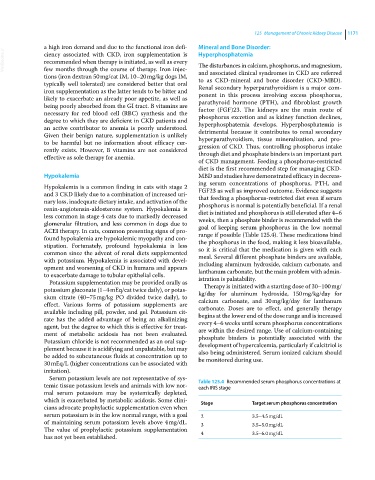Page 1233 - Clinical Small Animal Internal Medicine
P. 1233
125 Management of Chronic Kidney Disease 1171
a high iron demand and due to the functional iron defi- Mineral and Bone Disorder:
VetBooks.ir ciency associated with CKD, iron supplementation is Hyperphosphatemia
recommended when therapy is initiated, as well as every
The disturbances in calcium, phosphorus, and magnesium,
few months through the course of therapy. Iron injec-
tions (iron dextran 50 mg/cat IM, 10–20 mg/kg dogs IM, and associated clinical syndromes in CKD are referred
to as CKD‐mineral and bone disorder (CKD‐MBD).
typically well tolerated) are considered better that oral Renal secondary hyperparathyroidism is a major com-
iron supplementation as the latter tends to be bitter and ponent in this process involving excess phosphorus,
likely to exacerbate an already poor appetite, as well as parathyroid hormone (PTH), and fibroblast growth
being poorly absorbed from the GI tract. B vitamins are factor (FGF)23. The kidneys are the main route of
necessary for red blood cell (RBC) synthesis and the phosphorus excretion and as kidney function declines,
degree to which they are deficient in CKD patients and hyperphosphatemia develops. Hyperphosphatemia is
an active contributor to anemia is poorly understood. detrimental because it contributes to renal secondary
Given their benign nature, supplementation is unlikely hyperparathyroidism, tissue mineralization, and pro-
to be harmful but no information about efficacy cur- gression of CKD. Thus, controlling phosphorus intake
rently exists. However, B vitamins are not considered through diet and phosphate binders is an important part
effective as sole therapy for anemia.
of CKD management. Feeding a phosphorus‐restricted
diet is the first recommended step for managing CKD‐
Hypokalemia MBD and studies have demonstrated efficacy in decreas-
ing serum concentrations of phosphorus, PTH, and
Hypokalemia is a common finding in cats with stage 2 FGF23 as well as improved outcome. Evidence suggests
and 3 CKD likely due to a combination of increased uri- that feeding a phosphorus‐restricted diet even if serum
nary loss, inadequate dietary intake, and activation of the phosphorus is normal is potentially beneficial. If a renal
renin‐angiotensin‐aldosterone system. Hypokalemia is diet is initiated and phosphorus is still elevated after 4–6
less common in stage 4 cats due to markedly decreased weeks, then a phosphate binder is recommended with the
glomerular filtration, and less common in dogs due to goal of keeping serum phosphorus in the low normal
ACEI therapy. In cats, common presenting signs of pro- range if possible (Table 125.4). These medications bind
found hypokalemia are hypokalemic myopathy and con- the phosphorus in the food, making it less bioavailable,
stipation. Fortunately, profound hypokalemia is less so it is critical that the medication is given with each
common since the advent of renal diets supplemented meal. Several different phosphate binders are available,
with potassium. Hypokalemia is associated with devel- including aluminum hydroxide, calcium carbonate, and
opment and worsening of CKD in humans and appears lanthanum carbonate, but the main problem with admin-
to exacerbate damage to tubular epithelial cells. istration is palatability.
Potassium supplementation may be provided orally as
Therapy is initiated with a starting dose of 30–100 mg/
potassium gluconate (1–4 mEq/cat twice daily), or potas- kg/day for aluminum hydroxide, 150 mg/kg/day for
sium citrate (40–75 mg/kg PO divided twice daily), to calcium carbonate, and 30 mg/kg/day for lanthanum
effect. Various forms of potassium supplements are carbonate. Doses are to effect, and generally therapy
available including pill, powder, and gel. Potassium cit- begins at the lower end of the dose range and is increased
rate has the added advantage of being an alkalinizing every 4–6 weeks until serum phosphorus concentrations
agent, but the degree to which this is effective for treat- are within the desired range. Use of calcium‐containing
ment of metabolic acidosis has not been evaluated. phosphate binders is potentially associated with the
Potassium chloride is not recommended as an oral sup- development of hypercalcemia, particularly if calcitriol is
plement because it is acidifying and unpalatable, but may also being administered. Serum ionized calcium should
be added to subcutaneous fluids at concentration up to be monitored during use.
30 mEq/L (higher concentrations can be associated with
irritation).
Serum potassium levels are not representative of sys-
temic tissue potassium levels and animals with low nor- Table 125.4 Recommended serum phosphorus concentrations at
each IRIS stage
mal serum potassium may be systemically depleted,
which is exacerbated by metabolic acidosis. Some clini- Stage Target serum phosphorus concentration
cians advocate prophylactic supplementation even when
serum potassium is in the low normal range, with a goal 2 3.5–4.5 mg/dL
of maintaining serum potassium levels above 4 mg/dL. 3 3.5–5.0 mg/dL
The value of prophylactic potassium supplementation 4 3.5–6.0 mg/dL
has not yet been established.

